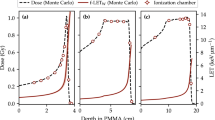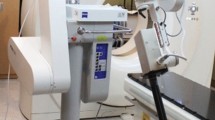Abstract
This study investigates the characteristics and application of the optically-stimulated luminescence dosimeter (OSLD) in cobalt-60 high dose rate (HDR) brachytherapy, and compares the results with the dosage produced by the treatment planning system (TPS). The OSLD characteristics comprised linearity, reproducibility, angular dependence, depth dependence, signal depletion, bleaching rate and cumulative dose measurement. A phantom verification exercise was also conducted using the Farmer ionisation chamber and in vivo diodes. The OSLD signal indicated a supralinear response (R2 = 0.9998). It exhibited a depth-independent trend after a steep dose gradient region. The signal depletion per readout was negligible (0.02%), with expected deviation for angular dependence due to off-axis sensitive volume, ranging from 1 to 16%. The residual signal of the OSLDs after 1 day bleached was within 1.5%. The accumulated and bleached OSLD signals had a standard deviation of ± 0.78 and ± 0.18 Gy, respectively. The TPS was found to underestimate the measured doses with deviations of 5% in OSLD, 17% in the Farmer ionisation chamber, and 7 and 8% for bladder and rectal diode probes. Discrepancies can be due to the positional uncertainty in the high-dose gradient. This demonstrates a slight displacement of the organ at risk near the steep dose gradient region will result in a large dose uncertainty. This justifies the importance of in vivo measurements in cobalt-60 HDR brachytherapy.









Similar content being viewed by others
References
Hoskin P, Coyle C (2011) Radiotherapy in practice-brachytherapy. Oxford University Press, Oxford
IAEA (2015) Implementation of high dose rate brachytherapy in limited resource setting. IAEA, Vienna
BEBIG, User List HDR Afterloading. 2015
Strohmaier S, Zwierzchowski G (2011) Comparison of (60)Co and (192)Ir sources in HDR brachytherapy. J Contemp Brachytherapy 3(4):199–208
IAEA (2001) Implementation of microsource high dose rate (mHDR) brachytherapy in developing countries, IAEA—TECDOC—1257. International Atomic Energy Agency (IAEA), Vienna
Van Lancker M, Storme G (1991) Prediction of severe late complications in fractionated, high dose-rate brachytherapy in gynecological applications. Int J Radiat Oncol* Biol* Phys 20(5):1125–1129
IAEA (2013) IAEA Human Health Report No. 8. Development of Procedures for In-vivo dosimetry in radiotherapy. IAEA, Wien
Kirov A et al. (1995) TLD, diode and Monte Carlo dosimetry of an 192Ir source for high dose-rate brachytherapy. Phys Med Biol 40(12):2015
Anagnostopoulos G et al (2003) In vivo thermoluminescence dosimetry dose verification of transperineal 192Ir high-dose-rate brachytherapy using CT-based planning for the treatment of prostate cancer. Int J Radiat Oncol Biol Phys 57(4):1183–1191
Andersen CE et al (2009) Characterization of a fiber-coupled Al2O3:C luminescence dosimetry system for online in vivo dose verification during 192Ir brachytherapy. Med Phys 36(3):708–718
Casey KE et al (2013) Development and implementation of a remote audit tool for high dose rate (HDR) Ir-192 brachytherapy using optically stimulated luminescence dosimetry. Med Phys 40(11):112102
Sharma R, Jursinic PA (2013) In vivo measurements for high dose rate brachytherapy with optically stimulated luminescent dosimeters. Med Phys 40(7):071730
Landauer I (2012) Inlight complete dosimetry system solution: nanoDot dosimeter. Landauer Inc, Glenwood.
Rivard MJ et al (2004) Update of AAPM Task Group No. 43 Report: A revised AAPM protocol for brachytherapy dose calculations. Med Phys 31(3):633–674
Jursinic PA (2007) Characterization of optically stimulated luminescent dosimeters, OSLDs, for clinical dosimetric measurements. Med Phys 34(12):4594–4604
Damkjær SMS, Andersen CE, Aznar M (2008) Improved real-time dosimetry using the radioluminescence signal from Al2O3: C. Radiat Meas 43(2):893–897
Tien CJ et al (2012) Optically stimulated luminescent dosimetry for high dose rate brachytherapy. Front Oncol 2:91
Jursinic PA (2010) Changes in optically stimulated luminescent dosimeter (OSLD) dosimetric characteristics with accumulated dose. Med Phys 37(1):132–140
Dunn L et al (2013) Commissioning of optically stimulated luminescence dosimeters for use in radiotherapy. Radiat Meas 51:31–39
Reft CS (2009) The energy dependence and dose response of a commercial optically stimulated luminescent detector for kilovoltage photon, megavoltage photon, and electron, proton, and carbon beams. Med Phys 36(5):1690–1699
Jursinic PA (2009) Angular dependence of dose sensitivity of surface diodes. Med Phys 36(6):2165–2171
Yukihara E, McKeever S (2008) Optically stimulated luminescence (OSL) dosimetry in medicine. Phys Med Biol 53(20):R351
Gaza R, Yukihara E, McKeever S (2004) The response of thermally and optically stimulated luminescence from Al2O3: C to high-energy heavy charged particles. Radiat Measur 38(4):417–420
Alves AD et al (2015) Long term OSLD reader stability in the ACDS level one audit. Australas Phys Eng Sci Med 38(1):151–156
Khan FM (2003) The physics of radiation therapy, 3rd edn. Lippincott Williams & Wilkins, Philadelphia
Ballester F et al (2005) Monte Carlo dosimetric study of the BEBIG Co-60 HDR source. Phys Med Biol 50(21):N309
Campos LT, de Almeida CEV (2015) Monte Carlo dosimetry of the 60Co BEBIG high dose rate for brachytherapy. PLoS One 10(9):e0139032
Mrčela I et al (2011) Optically stimulated luminescence in vivo dosimetry for radiotherapy: physical characterization and clinical measurements in 60Co beams. Phys Med Biol 56(18):6065
Yukihara EG, McKeever SW (2011) Optically stimulated luminescence: fundamentals and applications. Wiley, Hardcover
Al-Senan RM, Hatab MR (2011) Characteristics of an OSLD in the diagnostic energy range. Med Phys 38(7):4396–4405
Seymour EL et al (2011) In vivo real-time dosimetric verification in high dose rate prostate brachytherapy. Med Phys 38(8):4785–4794
Nath R et al. (1997) Code of practice for brachytherapy physics: report of the AAPM Radiation Therapy Committee Task Group No. 56. Med Phys 24(10):1557–1598
Waldhausl C et al (2005) In-vivo dosimetry for gynaecological brachytherapy: physical and clinical considerations. Radiother Oncol 77(3):310–317
Zaman Z et al (2014) Comparison of planned and measured rectal dose in-vivo during high dose rate cobalt-60 brachytherapy of cervical cancer. Physica Med 30(8):980–984
Acknowledgements
We wish to thank the Malaysian Ministry of Higher Education (UM.C/625/1/HIR/MOHE/MED/38) and University of Malaya Postgraduate Research Fund PPP (Grant Number PO026-2015B) for supporting this study. We also like to thank all integrating teams from the Department of Clinical Oncology and Department of Biomedical Imaging at UMMC for their help.
Author information
Authors and Affiliations
Corresponding author
Ethics declarations
Conflict of interest
The authors declare that they have no conflict of interest.
Ethical approval
This article does not contain any studies with human participants performed by any of the authors.
Informed consent
As no human participants are involved in this study, no informed consent is required.
Rights and permissions
About this article
Cite this article
Rejab, M., Wong, J.H.D., Jamalludin, Z. et al. Dosimetric characterisation of the optically-stimulated luminescence dosimeter in cobalt-60 high dose rate brachytherapy system. Australas Phys Eng Sci Med 41, 475–485 (2018). https://doi.org/10.1007/s13246-018-0647-6
Received:
Accepted:
Published:
Issue Date:
DOI: https://doi.org/10.1007/s13246-018-0647-6




